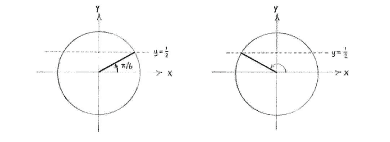Solution 4.4:1a
From Förberedande kurs i matematik 1
(Difference between revisions)
m |
|||
| (3 intermediate revisions not shown.) | |||
| Line 1: | Line 1: | ||
| - | + | In the unit circle's first quadrant, there is one angle whose sine value equals 1/2 and that is <math>v = \pi/6\,</math>. | |
| - | < | + | |
| - | + | ||
| - | [[ | + | [[Image:4_4_1_a.gif|center]] |
| + | |||
| + | From the figures, we see that there is a further angle with the same sine value and it lies in the second quadrant. Because of symmetry, it makes the same angle with the negative ''x''-axis as <math>v=\pi/6</math> makes with the positive ''x''-axis, i.e. the other angle is <math>v = \pi - \pi/6 = 5\pi/6\,</math>. | ||
Current revision
In the unit circle's first quadrant, there is one angle whose sine value equals 1/2 and that is \displaystyle v = \pi/6\,.
From the figures, we see that there is a further angle with the same sine value and it lies in the second quadrant. Because of symmetry, it makes the same angle with the negative x-axis as \displaystyle v=\pi/6 makes with the positive x-axis, i.e. the other angle is \displaystyle v = \pi - \pi/6 = 5\pi/6\,.

